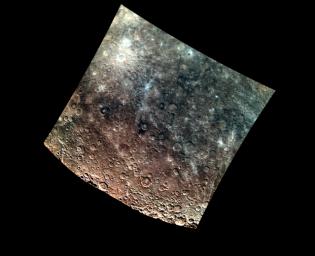The upper part of this view of Mercury's surface includes a swath of material that has reflectance that does not strongly increase toward longer wavelengths, a property described as relatively "blue" in color. The bluish material also has lower overall reflectance than Mercury's average surface. The terrain to the south and west has a more reddish color. A major puzzle of Mercury's geology is the identity of the particular rock types that correspond to these colors. Visible in the scene are the craters Amaral, Neruda and Sher-Gil.
This image was acquired as part of MDIS's 8-color base map. The 8-color base map is composed of WAC images taken through eight different narrow-band color filters and covers more than 99% of Mercury's surface with an average resolution of 1 kilometer/pixel. The highest-quality color images are obtained for Mercury's surface when both the spacecraft and the Sun are overhead, so these images typically are taken with viewing conditions of small incidence and emission angles.
Date acquired: July 05, 2011
Image Mission Elapsed Time (MET): 218360003
Image ID: 466480, 466483, 466481
Instrument: Wide Angle Camera (WAC) of the Mercury Dual Imaging System (MDIS)
WAC filter: 996-nm, 558-nm, 433-nm as red-green-blue.
Center Latitude: -51.62°
Center Longitude: 131.1° E
Resolution: 2471 meters/pixel
Scale: The edges of the image are about 2750 km (1700 mi.) long.
Incidence Angle: 55.3°
Emission Angle: 0.9°
Phase Angle: 55.5°
The MESSENGER spacecraft is the first ever to orbit the planet Mercury, and the spacecraft's seven scientific instruments and radio science investigation are unraveling the history and evolution of the Solar System's innermost planet. Visit the Why Mercury? section of this website to learn more about the key science questions that the MESSENGER mission is addressing. During the one-year primary mission, MDIS acquired 88,746 images and extensive other data sets. MESSENGER is now in a year-long extended mission, during which plans call for the acquisition of more than 80,000 additional images to support MESSENGER's science goals.
These images are from MESSENGER, a NASA Discovery mission to conduct the first orbital study of the innermost planet, Mercury. For information regarding the use of images, see the MESSENGER image use policy.

 Planetary Data System
Planetary Data System












